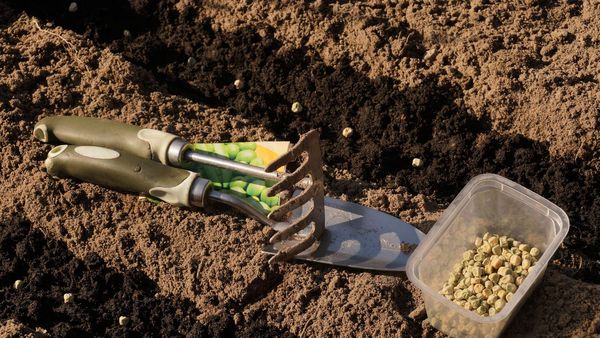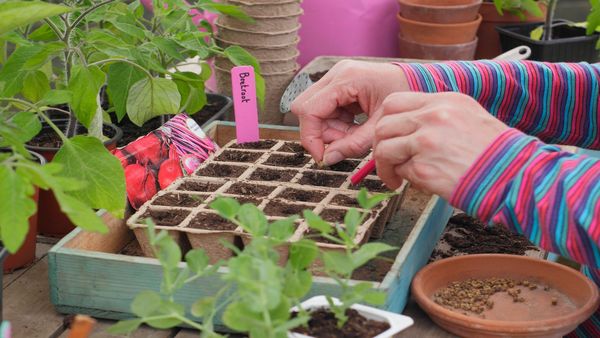
Though March remains chilly, the return of the bright and gently warming sun wakes dormant plants and seeds from their slumber, coaxes birds out to build their nests and beckons to the insects that sheltered through winter in undergrowth, nooks and crannies to emerge and flit about in the cool sun. This is a period of preparation and renewal. The garden is stirring.
Most plants need at least 10-12 hours of light a day to grow well. As we emerge from the dark half of the year, in the days that follow Valentine’s the sun finally gives us 10 hours of light. This gradually grows to 12 as we arrive at the spring equinox on 20 March, when day and night are equal. In the garden, it is a time of ever-increasing growth.
Today, the sun is joined in the pale-blue sky by streaks of loose clouds and the air is fresh. From the top of the old holly tree at the end of the garden, Mr Blackbird is decreeing to anyone who’ll listen that this garden and any other plots in range of his song are all his. I’m out here to sow seeds for his summer garden: tomatoes, peas, chamomile. All of these plants are easy to grow, pretty and tasty. They are also crops that can be expensive or hard to find in the shops, organic and grown in the UK. All three taste significantly better when harvested fresh from a blackbird’s garden than when bought from a supermarket.
I sprinkle the velvety little teardrop tomato seeds (I’m growing the varieties Moonglow, Santorini Tomotaki, Marmande and Indigo Rose) into rows in a single seed tray, each variety divided by a sideways cocktail stick and labelled. I scatter a fine layer of soil over them and then pop the tray in a basin of water to give the compost a soak.
For some plants, like tomatoes, it is not yet warm enough for reliable germination outdoors. In the main, a warm home is a good place to get March-sown seeds going, as they don’t necessarily need a great deal of light at this stage. In a few weeks, when their two juvenile leaves have emerged, I will gently prick them out. Softly pinching one of their delicate leaves between finger and thumb, I’ll slip a pencil below their young roots to carefully excavate the plant from its birthplace. I’ll then pop the seedling in a pot all of its own to grow big and strong, and begin to feed the gang of plants with a liquid brewed from nettles and chicken poop. These tomatoes, being tender, will stay in my house until early May then settle into their forever home in the unheated greenhouse.
Despite there now being enough light for tender plants to grow outside, it is still too cold for them. (I use the rule of thumb that if it’s chilly outside for me and I need to wear more than a T-shirt, they’re probably feeling the cold, too.) A sunny windowsill, warm conservatory or porch will do them well until the frosts pass, and day and night temps consistently reach 8-10C.
Some seeds like to germinate in the light of the sun. Chamomile is one such customer. The minute, dust-like seeds float down from my fingers on to the compost. I leave them there and their tray joins the tomatoes to soak. A hardy crop, once germinated in the warm chamomile will move into the unheated greenhouse.
Hardy plants are those that tolerate the cold. Some can take deep freezes and snow, others only mild winter chills. It’s worth finding out the hardiness rating of the crop you are sowing so you can cater to its needs. After the seeds have germinated, any hardy seedlings can be relocated somewhere with plenty of light that is not too warm. A cool, bright windowsill, conservatory, porch or cold frame would do. Or, for those lucky enough to have one, an unheated greenhouse is fine. If seedlings have too much warmth and not enough light they will grow “leggy”, which just means spindly and weak.
The peas, which are also hardy, I drop into two trails running along the bottom of a trench in a vegetable bed. The trench is about 15cm wide and 3cm deep, and the seeds fall about 5cm apart. As I’m direct sowing I sprinkle in a few extra for good luck. As they say: “Sow four seeds in a row, one for the rook, one for the crow, one will wither, the last shall grow.” I pinch the soil back over them, pat it down and then tuck them in with a sheet of bubble wrap to protect them from the cold while they germinate. Once they have grown a little I will give them pea netting to scrabble up.
Even without a sowing calendar, signs of rebirth outside tell us it’s time to reach for our seeds. Observing the gradual arrival of spring can help us adapt general guidance to our particular growing context; an invaluable skill that has benefits beyond the garden. We now know all too well that being connected to the rest of the living world is important for our physical and emotional wellbeing (Losing Eden by Lucy Jones and The Well Gardened Mind by Sue Stuart-Smith are both excellent explorations of this). Learning to be guided by cues from the wild can deepen our relationship with the living world and contextualise our gardens in the wider landscape, allowing us to experience ourselves as part of rather than separate from the rhythms of life on Earth.
Three jobs to do this spring
The garden’s warming up and you should, too. Here are some easy ways to get started
Make a no-dig bed
A “no-dig” bed is a great way of preparing a vegetable bed or border for spring. Every time the soil is dug or ploughed, stored carbon is released into the atmosphere, and repeated disturbance damages important life in the soil. It also leads to the long-term collapse of healthy structure and erosion. Making a no-dig bed is quick, easy and avoids these issues.
1. Dig any perennial weeds from the bed – things like brambles, nettles and docks.
2. Chop down any other vegetation and either leave it there to decompose in situ or move it to the compost heap.
3. Place a layer of cardboard on the patch. It’s possible to get cardboard boxes from most shops or supermarkets for free. This layer will exclude light, killing off any plants below, then rot into the soil, feeding the life there. Earthworms seem to love cardboard mulch.
4. Cover the card with 7-10cm of peat-free and organic or homemade compost.
5. The bed is then ready to be planted right away. Water it and then pierce through the card as you dig each hole. Or leave it to use later down the line.
My favourite seed suppliers
As much as I can, I like to source seeds that are ethically grown. I don’t like the thought that the seed that grows beauty in my garden could be causing hardship elsewhere. I choose seeds that are certified organic by the Soil Association or Biodynamic by Demeter and locally grown where possible, to support the local economy and because the shorter supply chains mean more transparency. Some of my regulars are Vital Seeds, Tamar Organics, Real Seeds, The Heritage Seed Library and Jekka’s Herbs.
Sort seeds and make a sowing plan
Summer crops can be sown right into May and then winter sowing begins, and successional sowing can continue throughout. So there is still plenty of time. Rather than rush into things, it’s best to take the time to make a good sowing plan to suit your garden. As Thomas Tusser says in his gardening book Five Hundred Points of Good Husbandry, written entirely in rhyme in the 1500s: in March, “Here learne to knowe what seeds to sowe.”
Poppy is working on her first book and next year will be regularly writing for the Observer Magazine. Follow her on Instagram @poppy.okotcha










